|
|
||
|
HOME
|
US Navy -
ships
|
US Navy - air
units
|
USMC - air
units
|
International
Navies
|
Weapon Systems
|
Special Reports |
||
|
Royal Navy
-
Aircraft Carrier R 08 HMS Queen Elizabeth |
||
|
||
| 11/24 | ||
|
Type,
class: Aircraft Carrier; Queen Elizabeth class Builder: various (block building, see info below) STATUS: Awarded: May 20, 2008 Laid down: July 7, 2009 Launched: July 17, 2014 Commissioned: December 7, 2017 IN SERVICE Homeport: HMNB Portsmouth, Hampshire Namesake: Queen Elizabeth I Ships Motto: SEMPER EADEM (always the same) Technical Data: see: INFO > Queen Elizabeth class Aircraft Carrier |
||
| images | ||
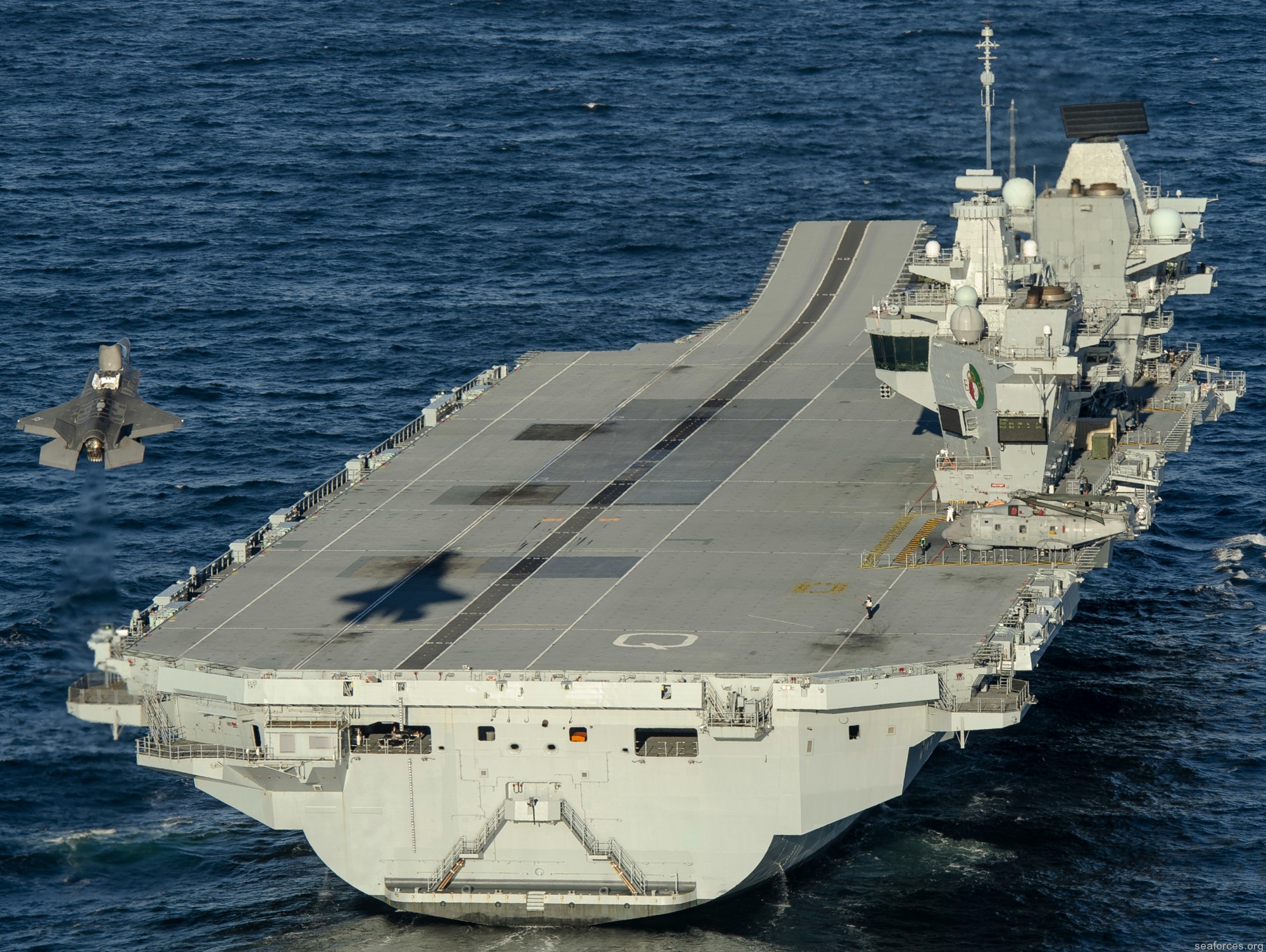  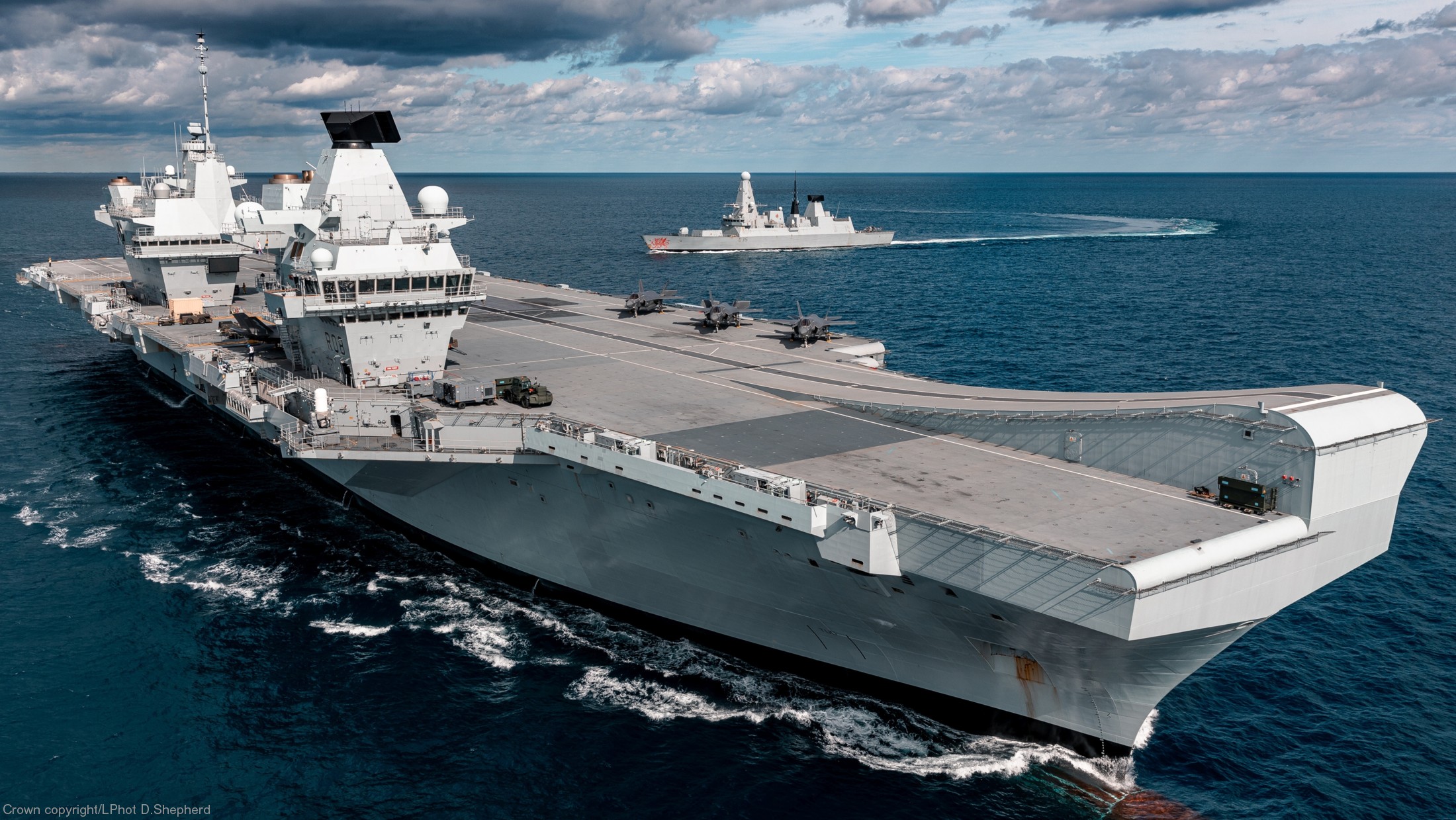            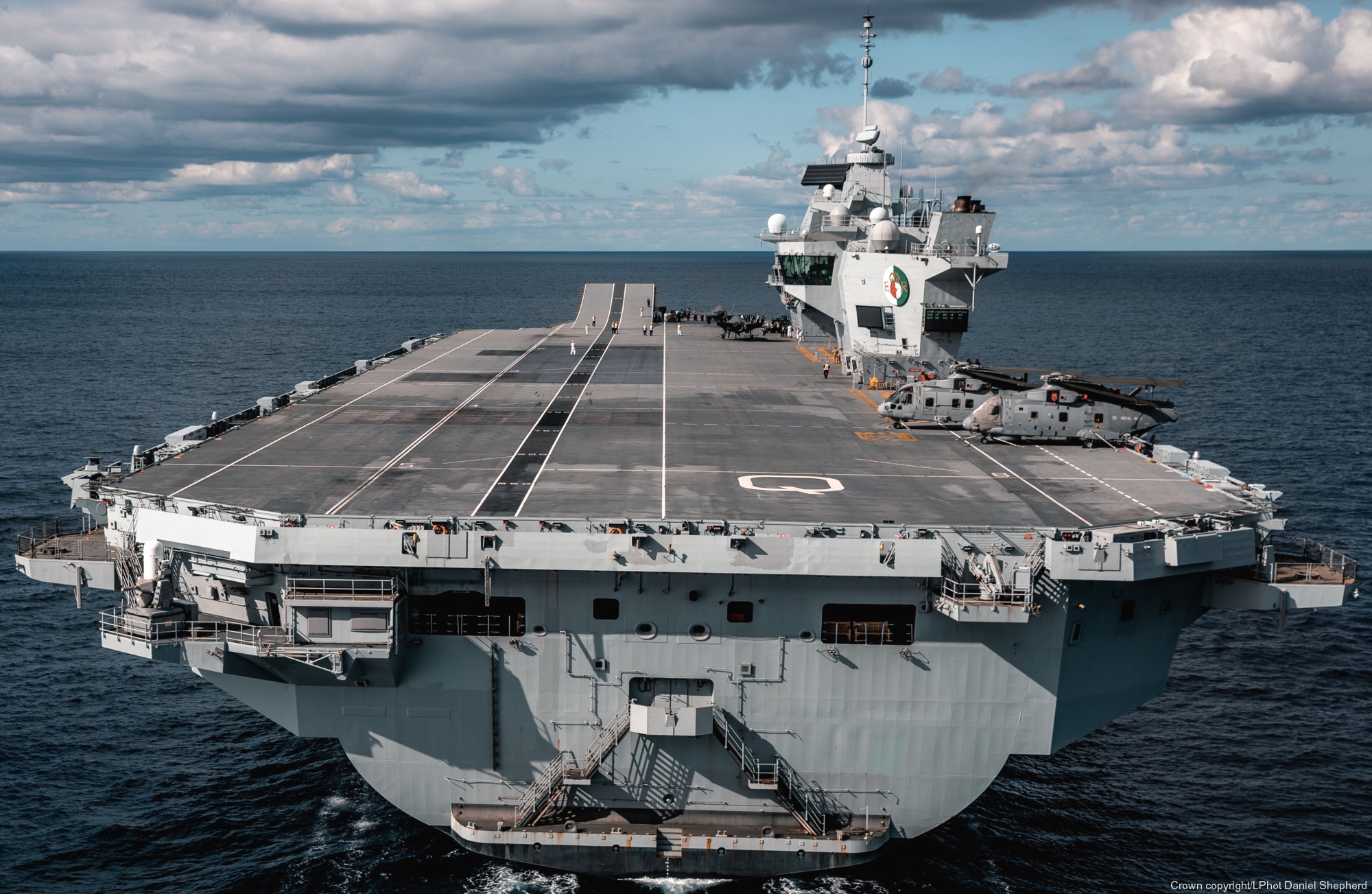                               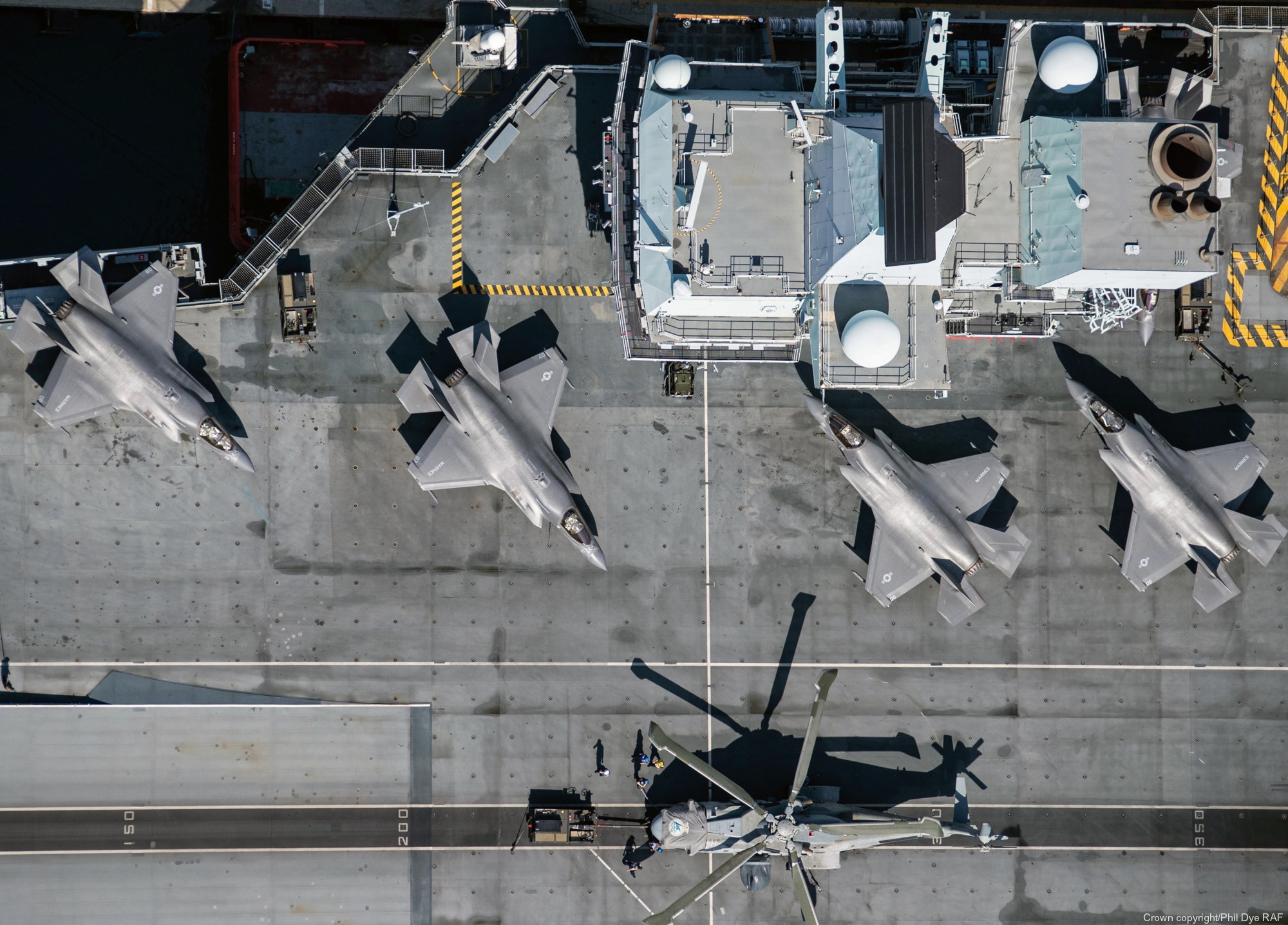         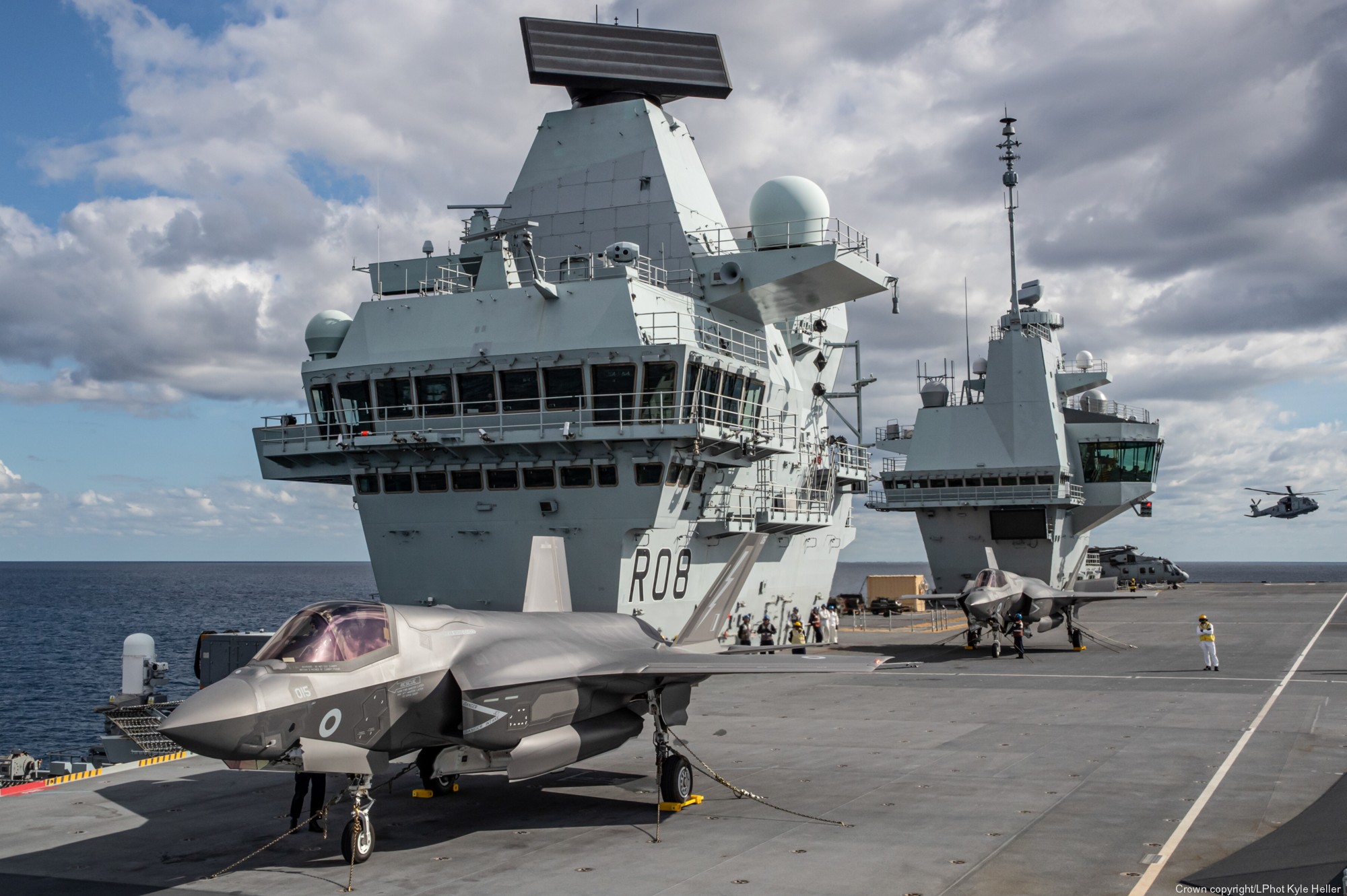          an USMC F-35B Lightning II aboard HMS Queen Elizabeth - September 2018          christening ceremony at Rosyth Shipyard, Edinburgh, Scotland - July 4, 2014      HMS Queen Elizabeth (R 08) and HMS Illustrious (R 06) at Rosyth dockyard, Fife, Scotland   |
||
|
HMS Queen Elizabeth (R 08): HMS Queen Elizabeth is the lead ship of the Queen Elizabeth class of aircraft carriers, the largest warships ever built for the Royal Navy of the United Kingdom and capable of carrying up to 60 aircraft. She is named in honour of the first Queen Elizabeth, a renowned World War I era super-dreadnought, which in turn was named after Queen Elizabeth I. The new Queen Elizabeth will carry her namesake's honours, as well as her Tudor rose-adorned crest and motto. The ship began sea trials in June 2017, and was commissioned on 7 December 2017. Her first Commanding Officer was Commodore Jerry Kyd, who had previously commanded the carriers HMS Ark Royal and HMS Illustrious. As Commanding Officer of HMS Queen Elizabeth, Kyd wore the Royal Navy rank of Captain, while retaining the substantive rank of Commodore. Queen Elizabeth has no catapults or arrestor wires and is instead designed to operate V/STOL aircraft. The air wing will typically consist of F-35B Lightning II multirole fighters and Merlin helicopters for airborne early warning and anti-submarine warfare. The design emphasises flexibility, with accommodation for 250 Royal Marines and the ability to support them with attack helicopters and large troop transports such as Chinooks. She is the second Royal Navy vessel to bear the name Queen Elizabeth and is based at HMNB Portsmouth. Design and construction: On 25 July 2007, the then Defence Secretary Des Browne, announced the order for two new carriers. At the time of approval the first carrier was expected to enter service in July 2015 and the budget was £4.085b for two ships.[24] The financial crisis led to a political decision in December 2008 to slow production, delaying Queen Elizabeth until May 2016. This added £1.560b to the cost. By March 2010 the budget was estimated at £5.900b and in November 2013 the contract was renegotiated with a budget of £6.200b. The in-service date was further extended to 2020 in the Strategic Defence and Security Review in October 2010. Construction of Queen Elizabeth began in 2009. The assembly took place in the Firth of Forth at Rosyth Dockyard from nine blocks built in six UK shipyards: BAE Systems Surface Ships in Glasgow, Babcock at Appledore, Babcock at Rosyth, A&P Tyne in Hebburn, BAE at Portsmouth and Cammell Laird (flight decks) at Birkenhead. Two of the lower main blocks, together weighing more than 6,000 tonnes and forming part of the base of the ship, were assembled and joined into one piece on 30 June 2011. On 16 August 2011, the 8,000-tonne Lower Block 03 of Queen Elizabeth left BAE Systems Surface Ships' Govan shipyard in Glasgow on a large ocean-going barge. Travelling 600 miles (970 km) around the northern coast of Scotland, the block arrived at Rosyth on the evening of 20 August 2011. On 28 October 2012, an 11,000-tonne section of the carrier began a lengthy journey around the south coast of England, avoiding bad weather from the shipbuilding hall at Govan to the Rosyth dockyard; it arrived on 21 November. The forward island was constructed at BAE Portsmouth and attached on 14 March 2013; the aft island was attached in June 2013. The ski jump was added in November 2013, leaving just the elevators and radar to be lifted into place. By September 2013 Queen Elizabeth was 80% complete internally. She is two and a half times the size of the Invincible-class, and has the ability to carry approximately three times as many aircraft. Despite this, Queen Elizabeth has marginally fewer crew than the Invincible-class. She is approximately three times as large as HMS Ocean. The ship has two superstructures, or islands, one for navigation and ship's operations and the other for flight control and aerial operations. The islands can take on each other's function in an emergency. Naming ceremony: Queen Elizabeth was named at Rosyth on 4 July 2014, by Elizabeth II, who said that the warship "marks a new phase in our naval history". Instead of smashing the traditional bottle of champagne on the hull, she used a bottle of whisky from the Bowmore distillery on Islay. The ceremony was attended by the Duke of Edinburgh (the Lord High Admiral), Admiral George Zambellas (First Sea Lord), senior naval officers from the United States and France, and by politicians including David Cameron and Gordon Brown (the Prime Minister and his immediate predecessor) and Alex Salmond (the then First Minister of Scotland). The official piece of music HMS Queen Elizabeth March, composed by WO2 Bandmaster John Morrish, was performed at the naming ceremony by HM Royal Marines Band, Scotland. This piece of music is a competition winning march chosen by the Carrier Alliance Group, performed and recorded by the Royal Marines Massed Bands. The ceremony also featured a fly-past by the Red Arrows and a second comprising Royal Navy, Royal Air Force and British Army helicopters. HMS Illustrious was berthed adjacent to Queen Elizabeth during the ceremony. The ship was floated out of dry dock on the morning of 17 July 2014. Fitting out was completed at the end of 2015 and the crew moved aboard in May 2016. On 24 May 2016, Commodore Jeremy Kyd assumed command of the ship from Captain Simon Petitt who had been the Senior Naval Officer since October 2012. Sea trials: Sea trials were planned beginning in March 2017 with delivery expected in May 2017, but technical issues delayed her trials. Prior to her departure from Rosyth, an extensive survey was carried out of the Firth of Forth by HMS Gleaner and 42 Regiment, Royal Engineers to gather information on the tides, the depth of the river bed, and the height of the three river crossings (Forth Bridge, Forth Road Bridge, and Queensferry Crossing). This was necessary as the most recent data available were 60 years old. Queen Elizabeth sailed on 26 June 2017 to undergo sea trials. The first stage of the operation was to move the ship from inside the fitting out basin, via one of the access gates, into the Firth of Forth itself, before taking her under the three Forth bridge crossings. Once this was accomplished, the ship took to the open sea off the east coast of Scotland to undertake the first set of trials, including handling and speed tests. During this period, Queen Elizabeth was accompanied by a pair of Type 23 frigates, HMS Sutherland and HMS Iron Duke, acting as escorts. The first aircraft to land on the ship was a Merlin HM.2 of 820 Naval Air Squadron on 3 July. Queen Elizabeth arrived at her first stopover at Invergordon, where the ship was fuelled and provisioned. At this point inspections of the hull were carried out. This opportunity allowed for defect rectification to be carried out prior to the ship returning to sea. During the stopover at Invergordon, Queen Elizabeth encountered the cruise liner of the same name, which was on a cruise around the British Isles. On 8 August 2017, Queen Elizabeth diverted from her sea trials to rendezvous with the ships engaged in Exercise 'Saxon Warrior'; this allowed for a photo exercise in company with the American Nimitz-class aircraft carrier USS George H.W. Bush and her battle group, comprising USS Donald Cook, USS Philippine Sea, HMS Iron Duke, HMS Westminster and HNoMS Helge Ingstad. Queen Elizabeth was scheduled to return to Rosyth at the end of July for rectification work based on the results of the ship's first sea trials, before putting to sea for a second time to undergo a series of mission system tests, prior to being handed over to the Royal Navy. This plan was abandoned and she instead steered for her home port, Portsmouth. Queen Elizabeth arrived at Portsmouth for the first time on 16 August 2017 and berthed at the newly renamed Princess Royal Jetty (formerly Middle Slip Jetty) within HMNB Portsmouth. On 30 October 2017, the ship departed Portsmouth for the first time for the second phase of her sea trials off the south and south-west coasts of England. For part of this second period of sea trials, she was accompanied by the Type 45 destroyer HMS Dragon. Queen Elizabeth returned to Portsmouth on 21 November 2017 to prepare for her official commissioning ceremony, which was held on 7 December 2017. Following the ship's commissioning, she underwent a period of defect correction in Portsmouth; one instance was a leak through a seal in one of the propeller shafts, which the Royal Navy stated was not serious enough to keep Queen Elizabeth from her planned programme. On 2 February 2018, Queen Elizabeth sailed from Portsmouth for a second time, for a six-week deployment to undergo the first phases of operational training; initially, the ship was scheduled to head into the Western Approaches to undertake her initial Operational Sea Training (OST) programme. Once complete, Queen Elizabeth was then taken into the North Atlantic for both heavy weather testing and operations to begin helicopter certification, including with Merlin Mk2 and Mk3 and Chinook helicopters. During this deployment, the ship made her first overseas port visit, stopping over in Gibraltar from 9 to 12 February. During this, the ship also began initial amphibious assault trials, with Royal Marines from 42 Commando embarked to simulate an air assault scenario. Queen Elizabeth was also scheduled to undergo a first replenishment at sea from RFA Tidespring; although this had to be abandoned due to bad weather, this allowed both ships the opportunity to simulate the scenario in detail. Queen Elizabeth returned to Portsmouth on 27 February 2018, berthing at Princess Royal Jetty. On 2 March 2018 in Portsmouth Harbour, Queen Elizabeth successfully tested her port side Marine Evacuation System (MES), a series of bright orange inflatable escape chutes and rafts. Queen Elizabeth departed Portsmouth for a third time on 10 June 2018, heading to the coasts of Cornwall for a second phase of helicopter flight trials. After the trials were completed, Queen Elizabeth headed for home and performed her first replenishment at sea (RAS) refuelling operation with Tidespring on 21 June 2018 in the English Channel, then returned to Portsmouth on 23 June 2018. On return from the initial OST and helicopter certification work, further work was undertaken to prepare the ship for operation of fixed-wing aircraft, in conjunction with regular maintenance and installation of her final weapons fit. Westlant 2018: Queen Elizabeth's first significant deployment took place during autumn 2018, when the ship was taken across the Atlantic to begin flying trials with her fixed-wing aircraft. Although the programme covers a range of areas, including the continued work-up of the Commander UK Carrier Strike Group and his staff, embarked for a deployment aboard for the first time, and small-scale exercises to test the ship's ability to land troops in the secondary amphibious role, the primary purpose is the first phase of fixed-wing flying trials involving the F-35B. These will cover two separate periods of approximately 3-4 weeks each starting in mid-September, and will utilize a pair of the instrumented development aircraft from VX-23, the US Navy's air testing unit at NAS Patuxent River. The testing programme saw the first launch of an F-35 from a ski-jump at sea (the F-35B has operated from the US Navy's assault ships, but these are not fitted with ski-jumps), and the first demonstration of the Shipborne Rolling Vertical Landing technique. In addition to the F-35 trials, Queen Elizabeth also began qualifications for types of aircraft operated by the US armed forces, including the V-22 Osprey. As part of the deployment, the ship made her first overseas port visit to New York City in October, in between layovers at Naval Station Norfolk, while there may also be some operations in the Caribbean, to test the ship's hot weather performance, as well as being on hand if needed for any disaster relief operations during the hurricane season. Queen Elizabeth is scheduled to return to the UK in December. On 18 August 2018, Queen Elizabeth, sailed from Portsmouth on what was termed as "Westlant 18", carrying three Merlin Mk2 helicopters of 820 NAS. Later, on 20 August 2018, three additional Merlin Mk4 helicopters from 845 NAS were embarked to the ship. Queen Elizabeth was then met by HMS Monmouth to form a carrier group. On 3 September 2018, Monmouth's Wildcat HMA2 helicopter became the first of its type to land aboard Queen Elizabeth. On 5 September 2018, the two ships arrived at Naval Station Mayport in north-east Florida, for a period of resupplying. The ships remained in Florida for eight days before departing for the planned trip northwards to Naval Station Norfolk. During the transit north, she planned to undertake an amphibious assault exercise off the coast of South Carolina using the embarked Merlin Mk4 helicopters, and Royal Marines of 42 Commando. However, due to the effects of Hurricane Florence, this exercise was cancelled and the group instead sailed south; Monmouth headed to waters off The Bahamas, which acted as a windbreak, while Queen Elizabeth skirted around the south of the hurricane zone. The group eventually arrived at Norfolk on 17 September. During the period alongside at Norfolk, Queen Elizabeth embarked a further 200 personnel of the F-35B Integrated Test Force, to undertake the testing and analysis of the two F-35B aircraft to be used during the initial set of flying trials. On Tuesday 25 September 2018, two US-owned F-35B test aircraft, based at Naval Air Station Patuxent River flew out to meet Queen Elizabeth off the New Jersey coast. After refuelling, Commander Gray then achieved the first F-35B takeoff from Queen Elizabeth using the ski-jump ramp. During the initial F-35B trials, Queen Elizabeth also began trials for the UK Carrier Group staff when the ship, along with Monmouth, formed a task group with the US Navy destroyer USS Lassen and USNS Supply, a fast combat support ship, which performed RAS with Queen Elizabeth and Monmouth on 1 October 2018. During October, the first instances of cross-decking took place when a US Navy MH-53E Sea Dragon helicopter, and a US Marine Corps tiltrotor MV-22B Osprey, both landed on board. The first Shipborne rolling vertical landing (SRVL) by an F-35 was undertaken on 14th October - this was also the first operational demonstration of the technique on a ship at sea, and is planned as the primary method of recovering fixed-wing aircraft aboard the Queen Elizabeth class. On 19 October 2018, Queen Elizabeth arrived in New York City for a planned seven day visit, during which Commodore Kyd handed command of the ship over to Captain Nick Cooke-Priest. She dropped anchor near Ellis and Liberty Islands in Upper New York Bay. During the ship's stopover, it played host to a forum hosted by Gavin Williamson, the Secretary of State for Defence, on the future of cyber security, as well as an international trade day hosted by Liam Fox, the Secretary of State for International Trade. On 19 November 2018, another milestone was met with a F-35B test pilot landing on the ship facing the stern instead of the bow. Post-Westlant 2018: Following the ship's return from Westlant 18, Queen Elizabeth began a maintenance period in early 2019 that saw the installation of the remainder of the ship's self-defence armament, with two Phalanx CIWS mounts fitted. This was followed by the ship's return to Rosyth to allow it to be dry-docked for its first scheduled hull inspection. The remaining Phalanx CIWS and four DS30M mounts will be fitted during 2020. After further fixed-wing aircraft trials in 2019, using British F-35 aircraft over UK waters, followed then by operational testing. Queen Elizabeth is expected to reach initial operational capability by 2020. Secretary of State for Defence Gavin Williamson announced that the ship's first deployment will be to the Mediterranean, the Middle East and the Pacific region, the last to counter China's territorial claims in the South China Sea. On 10 January 2019, Jane's Defence Weekly reported that F-35 aircraft of the United Kingdom would join the F-35Bs of the US Marine Corps in embarking Queen Elizabeth for the ship's first operational cruise in 2021. In May 2019, it was reported that Captain Cooke-Priest had been removed from command of Queen Elizabeth over an infraction concerning the use of the ship's official car. He was replaced by Captain Steve Moorhouse, who had originally been appointed as the first seagoing commanding officer of Prince of Wales. Westlant 2019: Queen Elizabeth departed for her second WESTLANT cruise on 30 August 2019. This deployment was to undertake the second stage of fixed-wing flight testing, and would see the F-35B employed as a full part of the ship's air group, with 617 Squadron due to embark for the first time to operate alongside 17 Squadron, the type's evaluation unit. The deployment will also see the first full up operation of the UK Carrier Strike Group, with Queen Elizabeth to be accompanied by HMS Northumberland and HMS Dragon, supported by RFA Tideforce. On 13 October 2019, F-35Bs from 17 Squadron landed on HMS Queen Elizabeth for the first time. HMS Queen Elizabeth arrived home in Portsmouth on 4 December 2019. On 16 December 2019, the first ever F-35B launch in British territorial waters took place, when an aircraft of that model took off from the flight deck of HMS Queen Elizabeth in Portsmouth Harbour. The aircraft, registration ZM148 (BK14) safely returned to its base at RAF Marham on the same day. ZM148 (BK14) had developed a fault during Westlant19 and was retained aboard Queen Elizabeth for repair. Post-Westlant 2019: Queen Elizabeth's third Captain, Commodore Steve Moorhouse was appointed Commander United Kingdom Carrier Strike Group. In succession, Captain Angus Essenhigh was appointed as the ship's new commanding officer, and will lead the carrier for final training to operational deployment in 2021. HMS Queen Elizabeth departed Portsmouth in January 2020 for flight trials in UK waters for the first time and was joined by British-owned F-35B Lightning aircraft from RAF No. 207 Squadron. In June 2020, F-35Bs from 617 Squadron landed on Queen Elizabeth for Operational Sea Training to prepare for Initial Operating Capability (Maritime) by the end of 2020. Initial Operating Capability was announced on 4 January 2021. Carrier Strike Group 2021: Between 7 and 21 May, the Carrier Strike Group took part in Exercise Strike Warrior, as part of Exercise Joint Warrior 21-1 Once the carrier strike group finished Exercise Strike Warrior, it made its way back to HMNB Portsmouth for final preparations, before finally departing on 23 or 24 May. On 21 May, Prime Minister Boris Johnson toured the ship. Queen Elizabeth II visited the ship on 22 May. Initially the group took part in joint exercises with NATO partners in the Eastern Atlantic, before entering the Mediterranean Sea, where it more conducted exercises with Mediterranean NATO allies, including with the French carrier Charles de Gaulle, in the dual-carrier exercise named Exercise Gallic Strike before entering port at Souda Bay for a logistic stop. A Type 45 destroyer, HMS Defender and HMNLS Evertsen detached from the group to enter the Black Sea - a visit that was already planned prior to the heightened Russian activity in the region. On 7 July 2021, the group transited the Suez Canal to enter the Indian Ocean where they conducted joint exercises with the Indian Navy before proceeding past Singapore, without stopping, to enter the disputed South China Sea region to conduct freedom of navigation exercises in the area with the US Navy. Subsequently, the group will pay a visit to South Korea and then conduct exercises with the Japan Maritime Self-Defense Force and United States Navy around the islands of Japan. On 18 June 2021, Queen Elizabeth began combat operations against ISIS, supporting Operation Inherent Resolve. F-35B aircraft from 617 Squadron, RAF and US Marine Fighter Attack Squadron 211 (VMFA-211) launched strikes from Queen Elizabeth to attack ISIS targets in Iraq and Syria. An outbreak of COVID-19 was reported on Queen Elizabeth and her escort ships on 14 July 2021. The British Defence Secretary stated that the outbreak was being managed and that all personnel in the Carrier Strike Group had been vaccinated against COVID-19. Mitigation measures were also in place aboard the warships including the use of masks, social distancing and a "Track and Trace system" to monitor personnel movement. The deployment proceeded as planned to Japan. On 26 July 2021, Queen Elizabeth and her escort ships conducted a passage exercise with three ships from the Republic of Singapore Navy (RSN) in the South China Sea. This is the first time that a Royal Navy Carrier Strike Group has conducted military exercises with the RSN. On 16 November 2021, one of the carrier's F-35B fighters, ZM152 from 617 Squadron, crashed during operations in the Mediterranean. The pilot was able to eject safely. Aircraft: The two ships of the Queen Elizabeth class are each expected to be capable of carrying forty aircraft, a maximum of thirty-six F-35s and four helicopters. The 2010 SDSR anticipated the routine peacetime deployment of twelve F-35Bs, but a typical warload will be 24 F-35Bs and some helicopters. These could be a Maritime Force Protection package of nine anti-submarine Merlin HM2 and five Merlin Crowsnest for airborne early warning; alternatively a Littoral Manoeuvre package could include a mix of Royal Navy Commando Helicopter Force Merlin HC4, Wildcat AH1, RAF Chinooks, and Army Air Corps Apaches. As of September 2013 six landing spots are planned, but the deck could be marked out for the operation of ten medium helicopters at once, allowing the lift of a company of 250 troops. The hangars are designed for CH-47 Chinook operations without blade folding and for the V-22 Osprey tiltrotor, whilst the aircraft lifts can accommodate two Chinooks with unfolded blades. Passenger transfer boats: The two ships of the Queen Elizabeth class can each carry up to three passenger transfer boats (PTBs) made by Blyth-based company Alnmaritec. Each PTB carries 36 passengers and two crew to operate the vessel. The boat is 13.1 m long and davit-launched. To enable the craft to fit into the docking area the navigation and radar masts are fitted with Linak actuators so that they can be lowered automatically from the command console. The enclosed cabin is heated and there is a set of heads forward. • The first boat named is named Swordfish, after the World War II-era Fairey Swordfish • A second PTB is named Buccaneer after the Blackburn Buccaneer • A third is named Sea Vixen, after the De Havilland Sea Vixen • A fourth PTB is named Sea Harrier, after the V/STOL British Aerospace Sea Harrier Weapons systems: Defensive weapons include the Phalanx Close-In Weapons System for anti-aircraft and anti-missile defence, and 30mm Automated Small Calibre Guns and Miniguns for use against fast attack craft. She would be escorted into high risk areas by the Type 45 destroyer, which was made specially to fulfil this role. In lower risk situations, frigates or even patrol vessels may be used instead. Highly Mechanised Weapon Handling System (HMWHS): Incorporated into the first two blocks is a sophisticated handling and deployment system for air weapons, with the aim of achieving a sortie generation rate which is about six times faster than any previous Royal Navy aircraft carrier. The system requires only 50 people and could be operated with as few as 12 in an emergency; it is estimated that 160 would be needed to produce the same efficiency with conventional equipment. The system moves munitions on pallets by means of remotely controlled electric vehicles and lifts. source: wikipedia |
||
|
Elizabeth I (September 7, 1533 - March
24, 1603) ... was Queen of England and Ireland from 17 November 1558 until her death. Sometimes called The Virgin Queen, Gloriana or Good Queen Bess, the childless Elizabeth was the fifth and last monarch of the Tudor dynasty. Elizabeth was the daughter of Henry VIII and Anne Boleyn, his second wife, who was executed two and a half years after Elizabeth's birth. Anne's marriage to Henry VIII was annulled, and Elizabeth was declared illegitimate. Her half-brother, Edward VI, ruled until his death in 1553, bequeathing the crown to Lady Jane Grey and ignoring the claims of his two half-sisters, Elizabeth and the Roman Catholic Mary, in spite of statute law to the contrary. Edward's will was set aside and Mary became queen, deposing Lady Jane Grey. During Mary's reign, Elizabeth was imprisoned for nearly a year on suspicion of supporting Protestant rebels. In 1558, Elizabeth succeeded her half-sister to the throne and set out to rule by good counsel. She depended heavily on a group of trusted advisers, led by William Cecil, Baron Burghley. One of her first actions as queen was the establishment of an English Protestant church, of which she became the Supreme Governor. This Elizabethan Religious Settlement was to evolve into the Church of England. It was expected that Elizabeth would marry and produce an heir to continue the Tudor line. She never did, despite numerous courtships. As she grew older, Elizabeth became famous for her virginity. A cult grew around her which was celebrated in the portraits, pageants, and literature of the day. In government, Elizabeth was more moderate than her father and half-siblings had been. One of her mottoes was "video et taceo" ("I see, and say nothing"). In religion she was relatively tolerant and avoided systematic persecution. After 1570, when the pope declared her illegitimate and released her subjects from obedience to her, several conspiracies threatened her life, all of which were defeated with the help of her ministers' secret service. Elizabeth was cautious in foreign affairs, manoeuvring between the major powers of France and Spain. She only half-heartedly supported a number of ineffective, poorly resourced military campaigns in the Netherlands, France, and Ireland. By the mid-1580s, England could no longer avoid war with Spain. England's defeat of the Spanish Armada in 1588 associated Elizabeth with one of the greatest military victories in English history. Elizabeth's reign is known as the Elizabethan era. The period is famous for the flourishing of English drama, led by playwrights such as William Shakespeare and Christopher Marlowe, and for the seafaring prowess of English adventurers such as Francis Drake. Some historians depict Elizabeth as a short-tempered, sometimes indecisive ruler, who enjoyed more than her share of luck. Towards the end of her reign, a series of economic and military problems weakened her popularity. Elizabeth is acknowledged as a charismatic performer and a dogged survivor in an era when government was ramshackle and limited, and when monarchs in neighbouring countries faced internal problems that jeopardised their thrones. Such was the case with Elizabeth's rival, Mary, Queen of Scots, whom she imprisoned in 1568 and had executed in 1587. After the short reigns of Elizabeth's half-siblings, her 44 years on the throne provided welcome stability for the kingdom and helped forge a sense of national identity. source: wikipedia |
||
| patches + more | ||
  |
||
|
|
seaforces.org
|
Royal
Navy start page
| |

